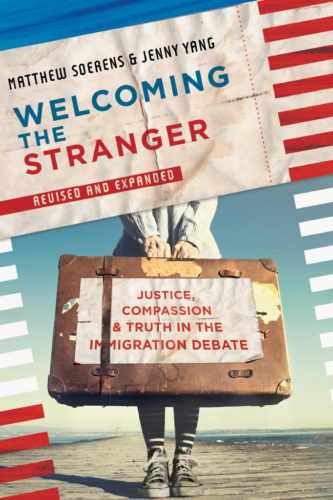“Francisco was up front about his legal status issues, but Alison presumed as they dated and moved toward marriage that, if he married a US citizen, this could be resolved easily. In hindsight, Alison says she was naive about immigration issues, having grown up in an ethnically homogeneous community where she had no real personal interaction with immigrants. If anything, she was confused by why Francisco wouldn’t have just come legally in the first place: “As Americans,” she says, “We have this skewed perspective. Since we can go anywhere, [we presume] anyone can go anywhere; since we can just fill out the paperwork, [we suppose] anyone can just fill out the paperwork” and be given legal status.” – From Soerens and Yang (2018), “‘Aliens’ among you: Who are undocumented immigrants?” Welcoming the Stranger, Chapter 2, p. 32

Chapter 2 Summary: Who are the immigrants among us?
This chapter focuses on answering the question “Who are the immigrants among us?” Despite being a nation of immigrants, it is very clear from our public conversations that relatively few Americans have meaningful relationships with recent immigrants. The assumptions that we share about the immigration system, the reasons why people migrate to the United States, how people reach this land, and the processes and procedures we have in place to protect our country do not reflect the complexity of the situation.
Key Discussion Questions
- The rhetoric surrounding undocumented immigrants is particularly fierce. How does the emotional rhetoric change the debate?
- In the story of Pedro and Martha, Social Security cards and taxes show the complexity of ethical dimensions in the issue of undocumented immigrants. If most undocumented immigrants pay taxes, what rights should they have under the law?
The revised edition has new family stories—that I won’t spoil here…
I enjoyed the revised version of this chapter very much, because it has been expanded with new, specific anecdotes of two immigrant families. One family is a “mixed status” family where at least one adult has lawful permanent residence, and the other family involves a more complicated case mixing childhood arrival and employer sponsored visas. These accounts are much needed and personalize the issue in tangible ways.
If the reasons for coming here have not changed, what has?
As I read this chapter and reflect on the broader debate, I can’t help but be reminded of the words we find in our own Declaration of Independence:
We hold these truths to be self evident, that all men are created equal, that they are endowed by their Creator with unalienable rights, that among these are life, liberty, and the pursuit of happiness.
Who is the Creator? Who are the men (and women) spoken of? Were they only American citizens, or are these all men? Let’s assume for now this “men” also included women. What does it mean to say these rights are unalienable? And when one is pursuing these rights, when can they be abrogated or forcibly alienated?
As we listen to the immigration debate, it becomes very clear, to me at least, that we don’t necessarily believe these words. Without passing judgment on our immigration laws or on those who break them, I believe we can at least discuss what type of immigration policies would uphold these values while protecting our nation. What would immigration policy that supports greater personal liberty look like? Would a policy that was founded on these values be more restrictive or more generous?
When we look with Soerens and Yang at the reasons people have immigrated to the United States, we see very little change over time. Work, escape from poverty or persecution, and asylum or simply the pursuit of happiness have always been the reasons people leave everything they’ve known to create a new life here. While the reasons have not changed over time, the ethnicities of those who have sought to integrate into our society have. And with each change, as we will see in the next chapter, we see that the reasons citizens provide for promulgating new restrictions on immigration remain consistent over time—even when the ethnic groups are different.

Reflection
This chapter has reminded me how important it is for us to connect with one another and hear each other’s stories. It is one thing to oppose the legalization of 3 million people’s residency in the US. It is another thing altogether to pray for God’s mercy in the lives of the family that sits next to us at church. As a risk analyst, I often think about the work of Paul Slovic. He is a psychologist who often discusses data he collects. His findings indicate that while we believe one death is a tragedy, even hearing about two or three eviscerates our compassion. Ten deaths, and orders of magnitude more, are just a statistic. When we can detach, our dispassionate analysis leads to inaction. But it is as if we need that personal connection in order to give meaning to our actions. We need to know to whom our efforts matter. Let us not forget that our efforts matter to our brothers and sisters.
Peace and Blessings, Royce
Editor’s note: Next week’s post will include a training update for the Saturday, October 20 Baltimore Running Festival half marathon.
Royce is an associate professor of engineering management and systems engineering at the George Washington University. He conducts and teaches under the broad theme “SEEDâ€: Strategic [urban] Ecologies, Engineering, and Decision making. His research and teaching interests include infrastructure sustainability and resilience measurement, risk analysis, and drinking water systems analysis. Royce is a member of the American Society of Civil Engineers (ASCE), and the Society for Risk Analysis (SRA).

Leave a Reply